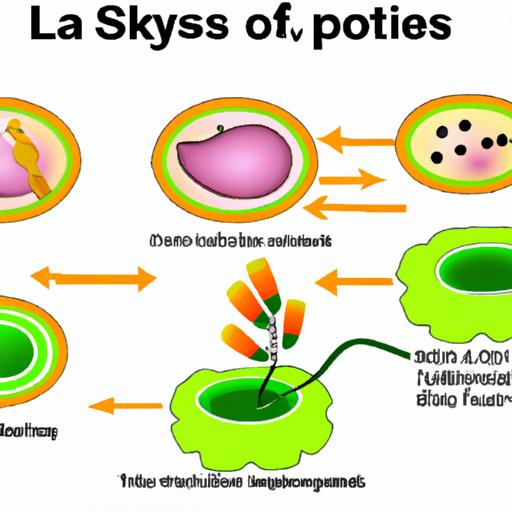Plants, the green wonders that surround us, possess an intriguing ability to produce their own food. Have you ever wondered where these magnificent organisms store their precious sustenance? Join me on a captivating journey as we explore the mysteries of plant food storage. Understanding this vital process not only enhances our knowledge of the natural world but also holds implications for agriculture and human nutrition.
Photosynthesis, the magical phenomenon that occurs within plants, forms the foundation of their food production. Through this intricate process, plants convert sunlight, water, and carbon dioxide into glucose, the primary source of nourishment for their growth and survival. But the question remains—where is this valuable glucose stored?
Delving deeper, we discover the key player in plant food storage: starch. This complex carbohydrate serves as a reservoir for energy. During photosynthesis, excess glucose is transformed into starch, which acts as a long-term storage molecule. But where does this remarkable starch reside within the plant?
Starch finds its place in various storage organs of plants. These organs, such as tubers, bulbs, and rhizomes, serve as specialized storage units, safeguarding the plant’s food supply. Picture it as nature’s pantry, filled with nutrient-rich treasures tucked away for times of need. But the wonders of plant food storage don’t end there.
Not all plants rely solely on storage organs for their nutritional security. Some employ alternative methods to safeguard their sustenance. Vacuoles, the tiny storage sacs within plant cells, act as miniature storehouses. Additionally, parenchyma cells, found in various plant tissues, contribute to food storage. These intriguing mechanisms ensure that plants can thrive and survive adverse conditions.
As we embark on this enlightening exploration of plant food storage, we uncover not only the physiological marvels of nature but also the potential benefits for humankind. The profound knowledge gained from unraveling these mysteries can revolutionize agricultural practices, leading to increased crop yields and improved food security. Furthermore, understanding plant food storage enhances our comprehension of human nutrition, enabling us to make informed dietary choices.
So, my fellow curious minds, let us embark on this botanical odyssey. Join me as we unravel the secrets of where plants store their food, unlocking the hidden treasures that sustain life itself. Prepare to be astounded by the wonders of nature’s nutritional abundance!
The Process of Photosynthesis
Photosynthesis, the remarkable process that sustains life on Earth, is a mesmerizing symphony of chemical reactions within plants. Let’s delve into the intricacies of this biological marvel and uncover the secrets behind plant food production.
A. Definition and Explanation of Photosynthesis
Photosynthesis, at its core, is the process by which plants create their own food. Through the power of sunlight, plants convert carbon dioxide and water into glucose, a vital energy source. This process occurs primarily in the chloroplasts, the green pigment-filled organelles found within plant cells.
B. Role of Chloroplasts in Capturing Sunlight
Within the chloroplasts lies a remarkable molecule called chlorophyll. It acts as nature’s solar panel, capturing sunlight and harnessing its energy. When sunlight strikes chlorophyll, it triggers a series of chemical reactions that initiate photosynthesis.
These chloroplasts, scattered throughout the leaves and other green parts of the plant, play a pivotal role in capturing the energy from sunlight. As the radiant energy is absorbed, it sets in motion the complex process of transforming raw materials into nourishing glucose.
C. Conversion of Sunlight, Water, and Carbon Dioxide into Glucose
Now, let’s unravel the intricate steps that occur during photosynthesis. First, with the aid of sunlight, plants absorb water through their roots and carbon dioxide from the air. These raw materials then journey through the plant, reaching the chloroplasts.
Within the chloroplasts, the energy from sunlight splits water molecules, releasing oxygen as a byproduct. Meanwhile, the carbon dioxide combines with hydrogen from the water to form glucose, a carbohydrate rich in energy. This miraculous transformation is facilitated by a series of enzymes and chemical reactions.
Glucose, the precious end product of photosynthesis, serves as the primary fuel for plant growth, development, and reproduction. However, not all glucose is consumed immediately. Excess glucose is converted into starch, a complex carbohydrate that can be stored for future use.
As we unravel the intricacies of photosynthesis, we gain a deeper appreciation for the remarkable process that underpins plant food production. This dance of sunlight, water, and carbon dioxide creates a symphony of life, enabling plants to thrive and nourish the world around them.
The Role of Starch in Plant Storage
A. Definition and Importance of Starch as a Plant Storage Molecule
Starch, a complex carbohydrate, plays a pivotal role in the storage of food within plants. As a long-term energy reservoir, it ensures the survival and growth of these remarkable organisms. But what exactly is starch, and why is it so crucial?
Starch is composed of glucose molecules linked together in a highly organized structure. It serves as a reliable source of energy for plants, providing the fuel needed for various biological processes. Just like a well-stocked pantry, starch grants plants the ability to endure periods of limited sunlight, water, or nutrients, ensuring their resilience in challenging environments.
B. Starch Formation During Photosynthesis
During the enchanting process of photosynthesis, plants harness the power of sunlight to convert carbon dioxide and water into glucose. Excess glucose, beyond immediate energy requirements, is transformed into starch. This conversion occurs within specialized organelles called plastids, specifically within the chloroplasts found in plant cells.
Within the chloroplasts, glucose molecules are rearranged and linked together to form starch. This conversion process is akin to organizing a scattered jigsaw puzzle, creating a compact and efficient storage molecule. By converting glucose into starch, plants can store a larger amount of energy in a condensed form, optimizing their ability to endure periods of scarcity.
C. Storage Locations for Starch in Various Plant Parts
Plants exhibit fascinating diversity in their storage strategies, with starch being stored in various plant parts. Let’s explore a few of these storage locations:
-
Roots and Tubers: Underground storage organs, such as roots and tubers, act as primary sites for starch accumulation. Examples include carrots, potatoes, and yams, where the swollen structures harbor copious amounts of starch, providing sustenance during dormancy or sprouting periods.
-
Seeds and Grains: Seeds, the embryonic plant structures, serve as reservoirs of starch. They provide the necessary energy for germination and early growth. Notable examples include rice, wheat, and legumes. These seeds are packed with starch, ensuring the vigor and vitality of future plant generations.
-
Bulbs and Rhizomes: Bulbs, such as onions and tulips, and rhizomes, like ginger and turmeric, serve as underground storage structures. Starch is stored in these specialized organs, enabling plants to survive adverse conditions and regenerate during favorable seasons.
-
Stem Parenchyma Cells: Plant stems, specifically the parenchyma cells within them, also contribute to starch storage. These cells, found in pith tissues, ensure a backup supply of energy for the plant, facilitating growth and survival during times of limited resources.
Through these diverse storage locations, plants distribute their starch reserves strategically, ensuring a constant supply of food throughout their lifecycle. This remarkable ability to store energy in different plant parts showcases nature’s ingenuity in adapting to varying environmental conditions.
As we unravel the significance of starch in plant storage, we gain a deeper appreciation for the intricacies of nature’s nutritional strategies. So, let us continue our botanical exploration, venturing further into the captivating world of plant food storage.
Storage Organs in Plants
Plants have evolved various storage organs to store their valuable food reserves. These specialized structures act as nature’s vaults, ensuring a steady supply of nutrients when resources are scarce. Let’s take a closer look at the diverse storage organs found in the plant kingdom.
A. Overview of Different Storage Organs in Plants
Storage organs in plants come in a multitude of forms, each uniquely adapted to serve the plant’s specific needs. These organs act as reservoirs, safeguarding the plant’s energy-rich food reserves for future use. Some common examples include tubers, bulbs, and rhizomes.
B. Examples of Storage Organs
-
Tubers: Potatoes are a prime example of tubers, swollen underground stems that store nutrients. These fleshy structures accumulate starch, allowing the plant to survive harsh conditions and fuel new growth when favorable circumstances arise.
-
Bulbs: Tulips and onions illustrate the bulbous storage organs. These structures consist of modified leaves packed with energy-rich compounds. Bulbs serve as a powerhouse for plants, enabling them to survive adverse seasons and produce vibrant blooms when conditions are favorable.
-
Rhizomes: Ginger and bamboo showcase rhizomes, horizontal underground stems that store nutrients. These elongated structures store carbohydrates, ensuring the plant’s resilience during dormancy and facilitating vigorous growth when conditions improve.
C. Detailed Explanation of How Storage Organs Store and Utilize Food
When it comes to storing and utilizing food, storage organs employ fascinating mechanisms. Once photosynthesis generates excess glucose, it is converted into starch, the primary energy-storage molecule. This starch is then transported and deposited within the storage organs, ready to be utilized when necessary.
During periods of growth or unfavorable conditions, plants tap into their food reserves. The stored starch is broken down into glucose molecules, providing the energy required for essential metabolic processes. These storage organs act as a lifeline, sustaining the plant until it can resume photosynthesis and replenish its food reserves.
In conclusion, storage organs play a vital role in a plant’s ability to endure challenging circumstances and ensure its long-term survival. Through the accumulation and strategic utilization of stored food reserves, plants exhibit remarkable resilience in the face of adversity. Understanding the intricacies of these storage organs allows us to appreciate the extraordinary adaptations that enable plants to thrive in diverse environments.
Other Storage Methods in Plants
Plants, ingenious beings that they are, have devised alternative methods to safeguard their precious food reserves beyond storage organs. Let’s explore these fascinating mechanisms and uncover how they contribute to the survival and resilience of plants.
A. Non-storage Organ Methods of Food Storage
While storage organs like tubers and bulbs are well-known for their role in food storage, plants have additional tricks up their sleeves. Two notable methods involve the utilization of vacuoles and parenchyma cells.
Vacuoles: Microcosmic Storehouses
Within plant cells, vacuoles serve as miniature storage sacs, akin to nature’s microcosmic storehouses. These specialized compartments not only house pigments, enzymes, and waste materials but also play a crucial role in storing excess food supplies. By efficiently storing surplus carbohydrates, proteins, and other vital nutrients, vacuoles ensure that plants have access to nourishment during periods of limited resources.
Parenchyma Cells: Versatile Food Reservoirs
Parenchyma cells, found in various plant tissues, boast an impressive versatility in their ability to store food. These functional cells possess abundant cytoplasm packed with nutrients, making them ideal storage units. From roots to leaves, parenchyma cells are strategically dispersed throughout a plant’s anatomy, ready to stockpile energy-rich compounds, such as starch and oils. Their widespread presence ensures that plants can rely on a distributed network of food reservoirs, enhancing their ability to endure challenging environmental conditions.
B. How These Methods Contribute to Plant Survival
The non-storage organ methods of food storage, utilizing vacuoles and parenchyma cells, play vital roles in ensuring the survival and resilience of plants.
Firstly, the presence of vacuoles allows plants to efficiently store excess food supplies. This strategic storage mechanism enables plants to thrive in environments where resources are scarce, providing a buffer against unpredictable conditions. By carefully managing their food reserves within vacuoles, plants can sustain their growth, development, and reproduction, even in times of limited nutrient availability.
Secondly, parenchyma cells act as versatile food reservoirs, strategically dispersed throughout a plant’s tissues. This distribution ensures a decentralized food supply, reducing the risk of complete nutrient depletion in specific regions. In times of stress or during unfavorable seasons, plants can tap into these reservoirs, mobilizing stored nutrients to support vital processes and facilitate survival.
Through these ingenious non-storage organ methods, plants demonstrate their adaptability and resourcefulness in the face of adversity. By efficiently storing and utilizing food resources, they ensure their continued existence, even in challenging environments.
Intriguing, isn’t it? These alternative storage methods highlight the remarkable strategies employed by plants to safeguard their nourishment. Join me as we delve further into the captivating world of plant food storage, uncovering the hidden intricacies that sustain these incredible organisms.
Conclusion
In conclusion, understanding where plants store their food is a gateway to unraveling the marvels of the natural world. The process of photosynthesis, with its intricate dance of sunlight, water, and carbon dioxide, lays the foundation for plant food production. The storage of this vital energy source, glucose, in the form of starch within specialized storage organs, ensures the plant’s resilience and ability to thrive.
Exploring the diverse storage methods employed by plants, such as storage organs and alternative mechanisms like vacuoles and parenchyma cells, provides a fascinating glimpse into the ingenuity of nature. These mechanisms are not only a testament to the adaptability of plants but also hold potential implications for agricultural advancements and human nutrition.
The significance of understanding where plants store their food extends beyond the realm of botanical curiosity. It has the power to revolutionize agriculture, leading to improved crop yields, enhanced food security, and sustainable farming practices. Additionally, the knowledge gained from studying plant food storage enhances our understanding of the role of nutrition in human health, empowering us to make informed dietary choices.
As we marvel at the wonders of plant food storage, let us remember the profound impact it has on our lives. From the humble tubers beneath the earth to the intricate cells within a leaf, the storage of plant food sustains life itself. So, as we continue to explore the mysteries of the natural world, let us cherish the intricate balance that allows plants to store their food and nourish the world around us.
In the grand tapestry of life, the secrets of where plants store their food remind us of the interconnectedness of all living beings. As we gaze upon a lush garden or a thriving forest, we can appreciate the intricate dance of nature, where every plant, every storage organ, and every molecule of food contributes to the vibrant symphony of life.




